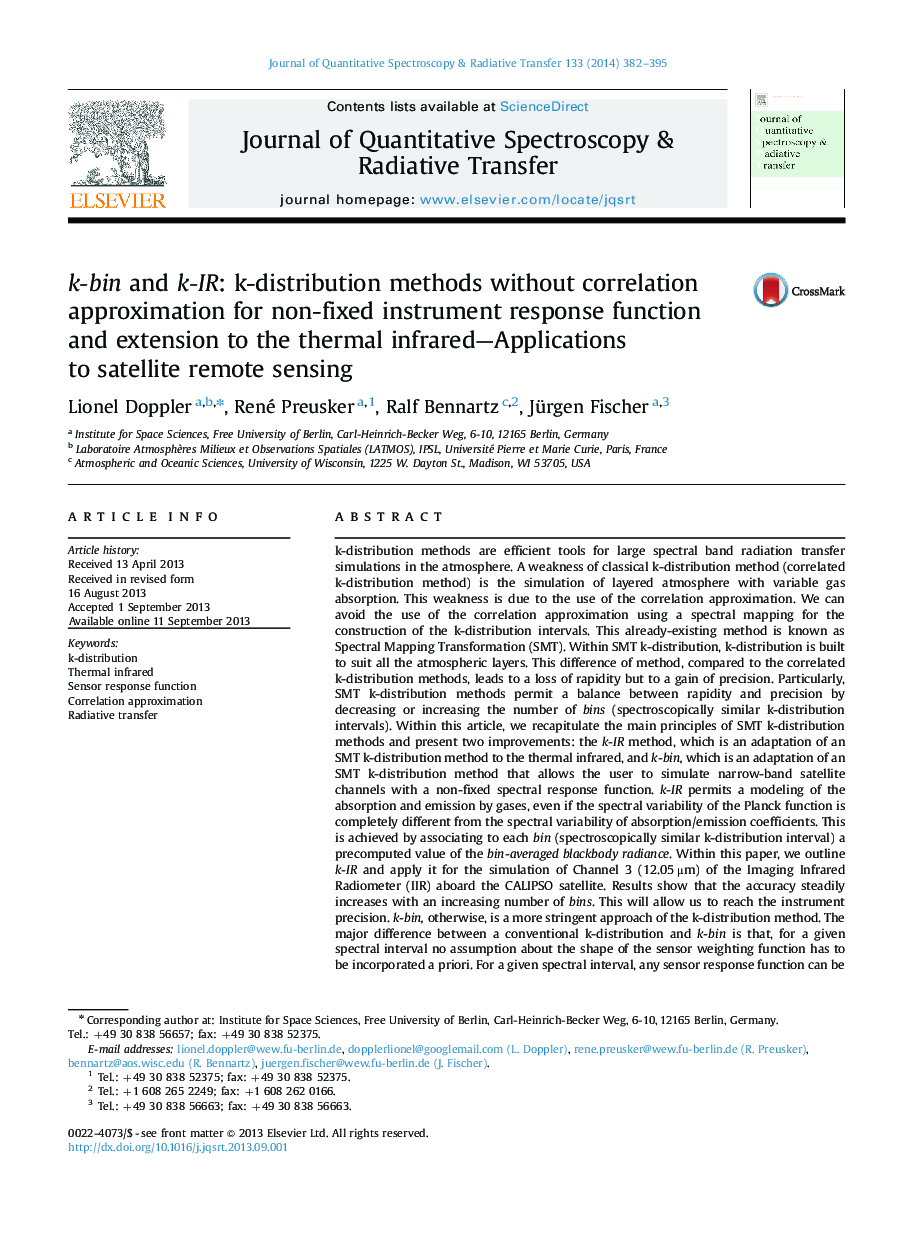| کد مقاله | کد نشریه | سال انتشار | مقاله انگلیسی | نسخه تمام متن |
|---|---|---|---|---|
| 5428531 | 1508682 | 2014 | 14 صفحه PDF | دانلود رایگان |

- We recall the principles of k-distribution without correlation approximation in general and of Spectral Mapping Transformation k-distribution methods.
- This method permits one to balance between precision and rapidity of radiative transfer simulation.
- k-IR is an extension of a Spectral Mapping Transformation k-distribution method to the thermal infrared.
- k-IR integrates the emission of radiation in the k-distribution using bin-averaged blackbody radiance.
- k-bin is an extension of a Spectral Mapping Transformation k-distribution method for non-fixed spectral response functions.
k-distribution methods are efficient tools for large spectral band radiation transfer simulations in the atmosphere. A weakness of classical k-distribution method (correlated k-distribution method) is the simulation of layered atmosphere with variable gas absorption. This weakness is due to the use of the correlation approximation. We can avoid the use of the correlation approximation using a spectral mapping for the construction of the k-distribution intervals. This already-existing method is known as Spectral Mapping Transformation (SMT). Within SMT k-distribution, k-distribution is built to suit all the atmospheric layers. This difference of method, compared to the correlated k-distribution methods, leads to a loss of rapidity but to a gain of precision. Particularly, SMT k-distribution methods permit a balance between rapidity and precision by decreasing or increasing the number of bins (spectroscopically similar k-distribution intervals). Within this article, we recapitulate the main principles of SMT k-distribution methods and present two improvements: the k-IR method, which is an adaptation of an SMT k-distribution method to the thermal infrared, and k-bin, which is an adaptation of an SMT k-distribution method that allows the user to simulate narrow-band satellite channels with a non-fixed spectral response function. k-IR permits a modeling of the absorption and emission by gases, even if the spectral variability of the Planck function is completely different from the spectral variability of absorption/emission coefficients. This is achieved by associating to each bin (spectroscopically similar k-distribution interval) a precomputed value of the bin-averaged blackbody radiance. Within this paper, we outline k-IR and apply it for the simulation of Channel 3 (12.05 μm) of the Imaging Infrared Radiometer (IIR) aboard the CALIPSO satellite. Results show that the accuracy steadily increases with an increasing number of bins. This will allow us to reach the instrument precision. k-bin, otherwise, is a more stringent approach of the k-distribution method. The major difference between a conventional k-distribution and k-bin is that, for a given spectral interval no assumption about the shape of the sensor weighting function has to be incorporated a priori. For a given spectral interval, any sensor response function can be constructed from a set of radiative transfer simulations. This requires somewhat different constraints in the way the subdivision in bins is performed, namely we must ensure that not only the band-averaged transmission is resembled to high accuracy, but also the transmission in each bin. Within this paper we outline k-bin method and apply it to high-resolution spectroscopic simulations in the oxygen A-band. k-bin allows for a representation of any channel (with a resolution of 0.04 nm or lower) within the oxygen A-band with an accuracy of 0.2% or better with less than 600 simulations. This corresponds for the Orbiting Carbon Observatory-2 (OCO-2) to a computational cost of 0.6 simulations per channel.
Journal: Journal of Quantitative Spectroscopy and Radiative Transfer - Volume 133, January 2014, Pages 382-395